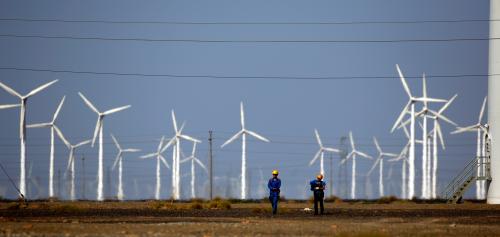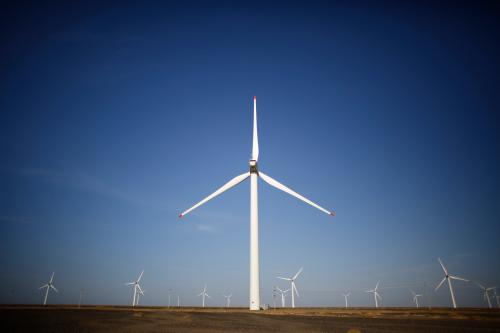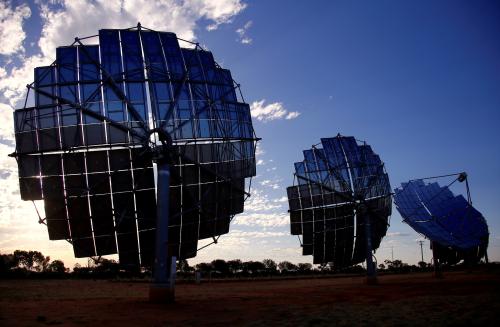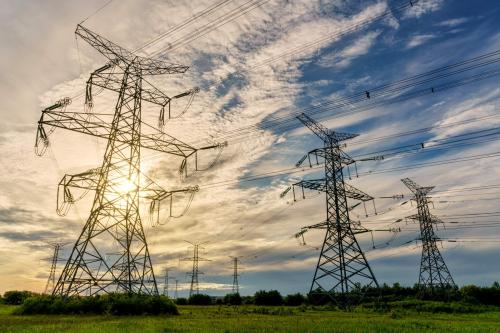Content from the Brookings-Tsinghua Public Policy Center is now archived. Since October 1, 2020, Brookings has maintained a limited partnership with Tsinghua University School of Public Policy and Management that is intended to facilitate jointly organized dialogues, meetings, and/or events.
With the “Shale Gas Revolution,” the United States has increased its natural gas production by 35% over the last decade. Fracking technology has had a huge impact on global energy markets. In 2015, the United States finally lifted its four-decade ban on oil and gas exports. In 2016, the first shipments of liquid natural gas (LNG) from the U.S. arrived in China. President Trump deems the U.S. “a big gas producer” and plans to expand both domestic and overseas markets. In 2017, U.S. LNG export capacity reached 20 billion cubic meters (bcm), of which 2.9 bcm were exported to China, accounting for 6% of China’s total LNG imports. By the end of 2019, the annual U.S. LNG export capacity is expected to reach 99 bcm, with an additional 53 bcm of capacity in the process of gaining approval from the Federal Energy Regulatory Commission. At the “Unleashing American Energy Event” in 2017, Trump announced that the U.S. Department of Energy would accelerate the process for approving LNG export facilities in Louisiana. Many of these exporters are targeting the Asian market for its great growth potential.
China is the fastest-growing consumer of natural gas in the world. The Chinese government has initiated projects and campaigns to replace coal with natural gas in factories and for residential heating, which are the main sources of air pollution. In 2017, China’s natural gas consumption increased by 15%, and its import grew by 28%. The country’s import dependency climbed from zero in 2005 to 39% in 2017. Although natural gas entails high costs and is subject to seasonal shortages, it offers tremendous social benefits. Air quality in metropolitan areas improved between 21% and 42% during the first phase of the National Air Quality Action Plan (2014-2017), having yielded significant social and health gains. The Chinese government is expected to wage the second phase of the anti-air pollution campaign in 2018, expanding efforts to replace current energy sources with cleaner alternatives. In addition, the government has acknowledged the crucial role of natural gas in combatting climate change and improving air quality as a “bridge fuel” to deepen renewable energy penetration. According to its National Energy Strategy, China plans to increase the share of natural gas in its energy mix to 15% by 2030. If, as experts projected, China’s primary energy consumption reaches 5.5 billion tons coal-equivalent by 2030, natural gas consumption will reach about 650 bcm, representing an increase of 2.7 times above the 2017 level.
China’s domestic supply looks less promising, due to a combination of unfortunate geology and poor institutional planning. While the Energy Information Administration of the U.S. Department of Energy estimates China to possess up to 361 trillion cubic meters (tcm) of shale gas deposits, which would be the world’s largest, only 218 tcm is technologically extractable according to the Chinese National Energy Administration (NEA). From an economic standpoint, availability is even lower due to geologic complexities, especially in areas where deposits are located more than 3,500 meters below ground. As of 2017, shale gas production represents only 6% of total domestic production. Although China has been implementing reforms in the sector, serious political and economic challenges lie ahead. The National Development and Reform Commission concludes that a significant boost in domestic supply is unlikely in the near future because of low investment in exploration, technological barriers, regulatory constraints, and inadequate infrastructure. The International Energy Agency predicts that China’s natural gas production will only reach 255 bcm by 2030, which means that at least 395 bcm—or 61% of total projected demand—will have to be met by some other means. Given China’s policy goals, expanding natural gas imports is the only way to meet this surplus demand.
Figure 1. China’s natural gas consumption, production and import volumes. (Data: NEA)

Pipeline Imports
Through bilateral and multilateral arrangements, China has actively ramped up natural gas imports via pipelines over the last decade. Today, the Central Asian Gas Pipeline (CAGP) and the China-Myanmar Oil and Gas Pipeline are the only two gas pipeline systems that flow into China. In 2017, gas traveling through these two pipelines accounted for 46% of overall imports, with more than three-quarters originating in Turkmenistan.
Two more pipelines are scheduled to come online within the next two years: Power of Siberia in 2019 and Line D of the CAGP in 2020. Line D will connect another gas field in Turkmenistan with China’s cross-country West-East Gas Pipelines, adding another 30 bcm of capacity to the CAGP. Power of Siberia—also known as the Eastern Line of the China-Russia Natural Gas Pipeline—is designed to transport 38 bcm of gas per year. After a significant delay, it is set to be fully operational in 2020. Although the China-Russia Western Line has also been negotiated, no meaningful steps have been taken toward construction.
Table 1. China’s natural gas import pipelines
 Source: China National Petroleum Corporation (CNPC).
Source: China National Petroleum Corporation (CNPC).
LNG
As of 2017, China imports 21 percent of its natural gas in the form of LNG. Australia has the greatest market share (47 percent), followed by Qatar (21 percent), Malaysia (11 percent), Indonesia (8 percent), New Guinea (6 percent) and the United States (6 percent). Melanie Hart of Center for American Progress, who is a leading expert in the field of China’s energy issues, argues that LNG from the U.S. is more expensive than many other sources, lacking competitiveness against other suppliers, especially when compared to pipeline imports from Central Asia. Although the authors make very good points, a couple of other factors should also be taken into account.
Figure 2. LNG supplies by source, 2017 (Data: EIA, Reuters, and authors’ calculation)
 First, existing suppliers of cheap LNG do not possess enough growth potential to meet future demand. Hart points out that U.S. LNG exports are more expensive than those from Australia, Malaysia, and Indonesia. However, these three countries will be unable to meet future increases in demand. According to the Department of Industry of Australia, the country’s projected LNG exports will reach roughly 120 bcm in 2030, which would meet only about 40% of the projected LNG demand in China. Malaysia will likely experience progressive declines in LNG exports in the 2020s as a result of natural limits to its gas reserves. Similarly , barring the discovery of meaningful new gas reserves, the IEA expects Indonesia to become a net-importer of LNG in 2023 because of strong increases in domestic consumption, especially in its industrial sector. As a result, the price of Malaysian and Indonesian LNG is likely to grow in the next decade due to tightened supply, making American LNG more competitive in the global market.
First, existing suppliers of cheap LNG do not possess enough growth potential to meet future demand. Hart points out that U.S. LNG exports are more expensive than those from Australia, Malaysia, and Indonesia. However, these three countries will be unable to meet future increases in demand. According to the Department of Industry of Australia, the country’s projected LNG exports will reach roughly 120 bcm in 2030, which would meet only about 40% of the projected LNG demand in China. Malaysia will likely experience progressive declines in LNG exports in the 2020s as a result of natural limits to its gas reserves. Similarly , barring the discovery of meaningful new gas reserves, the IEA expects Indonesia to become a net-importer of LNG in 2023 because of strong increases in domestic consumption, especially in its industrial sector. As a result, the price of Malaysian and Indonesian LNG is likely to grow in the next decade due to tightened supply, making American LNG more competitive in the global market.
Second, growth in international pipeline supply will be insufficient to meet new demand. Even if all of the above-listed projects become fully operational by 2030, pipeline gas will only reach a maximum of 165 bcm, which would meet 42% of China’s projected demand for imports. In reality, pipelines are usually underutilized due to various seasonal, economic, technological, and political constraints. In 2017, China imported 43 bcm of natural gas via four lines that had a combined designed-capacity of 78 bcm. In other words, only 55% of existing pipeline capacity was utilized. Even worse, the utilization rate for the China-Myanmar pipeline was only 33%. Although China’s Belt and Road Initiative sets energy cooperation as an utmost priority, we estimate the volume of imports through pipelines will be around 95 bcm/year by 2030, leaving a shortfall of 300 bcm, or 46% of the overall projected demand for LNG.
Third, international pipeline gas supply depends as much on bilateral relations and geopolitics as it does on the market. As China’s largest supplier, Turkmenistan has grown increasingly concerned about its dependency on China and is seeking to boost exports to Europe and Indian in order to hedge against political and economic risks. During a wave of shortages last December, the China National Petroleum Corporation sent its former head manager of Turkmenistan to the country to arrange for an increase in supply of around 30%. However, by the end of January 2018, supply from Central Asia had been cut by more than 40%, causing an immediate shortage in northern China. Instability and risks such as these prompt China to seek supply diversification.
Unlike pipelines based on bilateral contracts, the global market for LNG is more mature, with a set of mechanisms in place to secure the stability of supply. With the proliferation of flexible-destination contracts and a growing number of players, shorter contracts and spot markets have become more popular in the natural gas business over the past decade. These mechanisms allow China to hedge against economic and political risks associated with long-term deals. A combination of short-term and long-term contracts expands China’s accessibility to various supply sources, contributing to its overall energy security.
In that sense, importing natural gas from the U.S. suits China’s economic interests and energy security goals. Whereas most of China’s contract partners for LNG and all of its contract partners for pipeline gas determine the price of natural gas by indexing to oil, the U.S. uses the Henry Hub price, which is consistently lower and less volatile. Adding Henry Hub supply to an oil-linked LNG portfolio brings higher stability due to the inclusion of a large fixed component and the low correlation between Brent and Henry Hub. U.S. gas will become more competitive if oil prices rebound. The abundant and stable supply of natural gas from the U.S. can help balance China’s import portfolio by avoiding potential disturbances from risky and conflict-ridden areas.
Moreover, boosting LNG imports makes economic sense, as import terminals are closer to demand centers along China’s east coast. China’s natural gas distribution system consists of trunk pipelines and provincial and local distribution networks. While the “Three Barrels” companies operate the cross-country pipelines, local transmission networks are run by various local distribution companies. This fragmented structure incorporates transportation tolls at every level, reducing the economic competitiveness of pipeline imports. Transportation fees for pipeline imports from Xinjiang to Guangdong can reach about seven times the cost of the fuel being conveyed. Taking into account these high transportation costs, Turkmenistan supplies are much more expensive than U.S. LNG imports, especially for the east coast. Therefore, pipeline supplies can only meet demand in western China. In addition, LNG can be transported on trucks. This is especially important when it comes to replacing coal combustion in rural areas, where the storage and distribution networks are weak.
LNG trade between the U.S. and China is a meaningful way to help rebalance trade between the two countries. Increasing the U.S. share of Chinese LNG imports to 20% of future demand at a price of $10/mmbtu, for instance, would be equivalent to $21 billion. At the 2017 Sino-U.S. presidential summit in Florida, President Xi and President Trump found common ground in seeking to expand bilateral trade in natural gas. In fact, cooperation around natural gas should not be limited merely to LNG. In the near future, China will have to improve its domestic energy infrastructure, especially its storage systems, to facilitate increased consumption of natural gas. Chinese state-owned enterprises lack the experience and technology for site selection, design and security management. This is another area where U.S. companies can play an augmented role in the Chinese market, assisting with facility construction, operational services for portal and distribution networks, and storage systems. All of these factors can contribute to a meaningful rebalance of the U.S.-China trade relationship.







Commentary
U.S. gas to China: Positive energy for bilateral relations
May 31, 2018